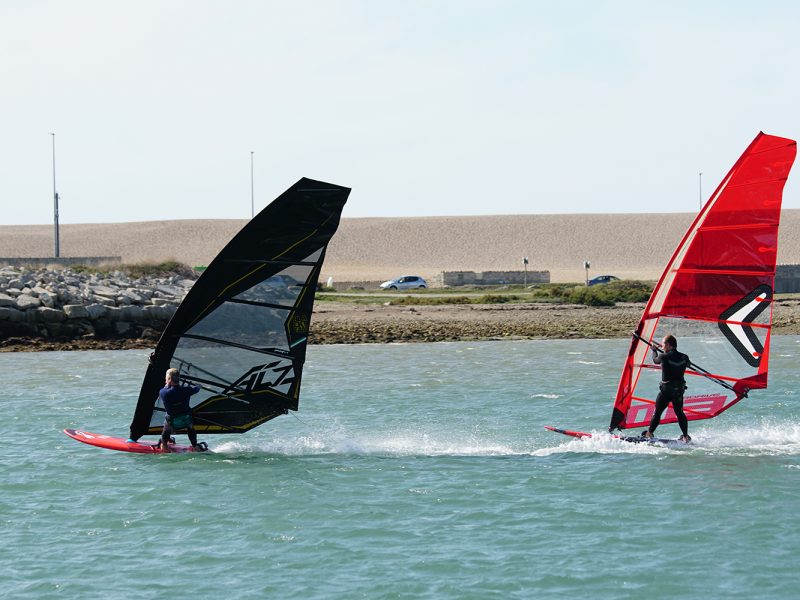8.0 MULTI-CAM SAIL TEST 2020
Clik here to view.

TO CAM OR NOT TO CAM?
8.0M MULTI-CAM SAIL TEST 2020
In our last test instalment for 2020 equipment, we look at multi-cam sails, from the twin cam to a full four-cammed no-compromise offering. Is the camber inducer purely the domain of the racer and the straight-line fanatic, or should more riders seriously consider one for their recreational quiver?
Test Editor Tris Best // Second Testers Maurin Rottenwalter and Joe North
Photos Dan Hallam and Bryony Webb
//Test location Portland Harbour.
This test was originally published in the October 2020 issue of Windsurf Magazine.
Circle back to the first half of the nineties and it was a given that sails above 6.0m in size had to have at least one camber inducer in their makeup to ensure stability was maintained when powered or overpowered. It meant that nigh on everyone, bar the ardent wave sailor, had a cammed sail in their quiver. The landscape was then changed forever in the mid to late nineties with the introduction of the Naish Noa – a seven batten no-cam ‘slalom sail’, bringing rigging ease and practicality to the larger sail market. As a result, cams quickly became a dirty word, synonymous with heavy, rigid and lifeless sails, which largely amounted to hard work both in rigging and on the water. So has the backdrop changed again? Should we all be considering cammed sails again?
FINDINGS
The simple fact is that the benefit of a cam to the structure of a sail cannot be disputed. Forcing a deeper profile into the draft, it generates a more powerful engine and then goes on to provide more stability as the wind increases. Over time, the negative impacts levelled at cams have also been tackled. Some brands have reduced luff sleeves, for example, to reduce the water retained before a waterstart, or neoprene closures have been included in the boom cutout to mitigate water ingress. Cams have been redesigned time and again to make rigging as easy and as practical as possible, meaning most are now capable of being rolled onto the mast without the need for any outhaul tension beforehand. But one of the biggest changes in sail development over recent years is the ability to reduce a sail’s luff curve without compromising its stability. Through longer luff lengths, and clever use of new materials and/or their layup, most modern cammed sails tend to feature less forced curvature in their leading edge, allowing the mast to flex and respond and providing the sail with more life, lightness and response in the hands. Cammed sails are here to stay and if you’re looking to maximise your time or performance on the water, they may well be the ticket. Just one small caveat worth mentioning before we sign off though: some of these sails provide near race sail levels of performance, so to keep them behaving as they are designed to do so, they need to be partnered with a board and fin that can match their potential. Anything less and the sail will begin to express its displeasure at being held back by manifesting some control issues.
SUMMARY
The Simmer 2XC is such an easy, comfortable twin cam to get on with, that it will make even the most hesitant passenger wonder why they hadn’t tried cammed sails before. The Exceed by Gunsails is also from a similar background, more full-bodied and powerful, with increased area above the boom, yet balanced and incredibly manageable over a wide wind range. The Ezzy Lion has the narrowest luff sleeve of the group, yet the deepest profile, its new x-ply window providing a crisper feel and response over a seemingly limitless range. The Goya Mark 2 is the last twin cam in this test group, a sail with a prescribed set and plenty of luff curve, structure and skin tension, that can be re-tuned with less to maximise its range on more marginal days. The Severne OverDrive M3 and GA Sails Phantom sit closely on the development spectrum to their full race counterparts, both benefitting from reduced luff curves and the very latest in material use to retain form. The OverDrive M3 is all about lightness of handling, whilst the Phantom surprised us with its life and range on one setting. The two three-cam all-rounders in the group are the Duotone S_Pace and SwitchBlade from Loftsails, both possessing an almost chameleon like ability to change their colours and nature, simply through tuning. The S_Pace feels small and belies its size; the SwitchBlade being at the other end of the scale – big, bold and omnipresent. That leaves the X-Wing from RRD – the full race contender with four cams and a massive luff sleeve. It may well be a step too far for many, and needs to be sailed in powered to overpowered conditions to appreciate its worth … but my gosh was it fun to use and shows just how accessible these top-end sails actually are today. The final sail to mention is the AC-Z from Point-7 – a new design for them, with two cams low down in an enlarged luff sleeve, becoming a standard rotational sail above the boom. We’ll leave you to read the full review later on in this issue, suffice to say that it’s great to see new concepts continually being introduced that inject all the knowledge and progression at the cutting edge of the sport into a meaningful package for the wider market.
THE LINEUP
The post 8.0 MULTI-CAM SAIL TEST 2020 appeared first on Windsurf Magazine.